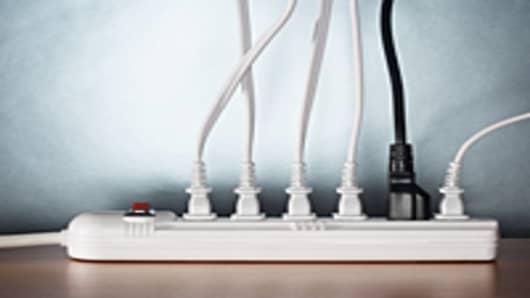If the fear of running out of power on an interstate has given you pause about buying one of the new gas-electric models — even with sky-high gasoline prices — then you understand one of the major sticking points keeping electric utilities from generating huge amounts of solar and wind-powered electricity.
Often called the holy grail of renewable energy, large-scale electricity storage is a requirement for utilities like Duke Energy), which must ensure 4 million customers’ lights will stay on even when the wind stops blowing and the sun isn’t shining.
Even when renewable energy is relatively cheap to produce, current costs to store huge amounts of solar and wind power can be two or three times the value, according to a recent report by the Electric Power Research Institute, an industry-funded nonprofit research group.
“The person who can invent a way to store large amounts of energy is going to be the next Bill Gates,” says Jacques Besnainou, North American head of the French nuclear conglomerate, AREVA.
AREVA, like other major suppliers to the utility industry, is developing its own energy-storage system, as it supports growing demand for renewable energy.
In fact, a number of companies are involved in developing large-scale storage technologies, and those players may be worth a look by investors hoping to provide their portfolios with some juice.
Most utilities now rely heavily on pumped hydro storage to manage demand peaks and valleys in the electricity grid system. Pumped hydro uses water flowing downhill to turn large turbines and generate electricity. Excess power generated during slow demand periods is used to send the water back uphill again.
Pumped hydro systems account for some 127 gigawatts of energy storage capacity, or 99 percent of current storage worldwide, and there are nearly 40 active applications to build new pump hydro facilities, according to EPRI.
But pumped hydro takes a long time to approve and build. Meanwhile, a wave of new technology partly financed by $250 million in federal stimulus funding is expected to emerge beginning this year, helping to advance grid-integrated storage solutions, according to Dan Rastler, head of EPRI’s energy storage program.
“This has been an area that’s been growing in interest quite exponentially the last three or four years,” he says. “The public and private venture capital firms have been looking at this space quite seriously.”
Several players in grid-scale storage are startups or early stage companies with public company backing.
For example, privately held Xtreme Power, backed by more than $50 million in funding from investors including Fluor Corp. , BP and Dominion Resources, is building what will be the world’s largest energy storage system for a wind farm.
The 36-megawatt battery storage system for Duke Energy’s 153-megawatt wind farm in West Texas is expected to cost $43 million and be operational by late next year.
Pavel Molchanov, an alternative energy analyst at Raymond James, expects grid storage will remain “essentially a development stage market for the next two years.” He doesn’t cover any of the power storage stocks yet.
But some small- and micro-capitalization companies who are now focused on electric vehicles and other smaller scale systems could apply their technology to produce grid solutions, according to Molchanov and other industry analysts.
Small Firms, Big Bets
Investors, however, may need strong stomachs. Many of the companies are losing money.
Here's a snapshot of some of the players.
Beacon Power has developed flywheel-based storage systems and is currently using federal stimulus funds and grants to help develop 20-megawatt storage plants in New York and Pennsylvania.
Wall Street analysts expect the company to narrow its 2011 losses from those of last year ($22.7 million) as revenue rebounds. Beacon, however, reported only $5.5 million in cash as of March 31, and its shares have fallen 67 percent over the past year.
Valence Technology is a pure play in lithium batteries, which have been a focus of investors eyeing growth in electric passenger vehicles. Importantly, Valence makes batteries for heavy-duty fleet electric and hybrid vehicles , including trucks made by Electric Vehicle International that UPShas been testing in the U.S. Valence’s focus on heavy-duty battery applications should help future development, says Michael Lew, an analyst with Needham & Co., who rates the stock a buy.
“Valence is well situated,” says Lew.
A123 Systems , another key player in vehicle batteries, is developing 20 megawatts of storage for a power grid project in Chile being handled by AES Corp. . A123 said in February its shipments so far make it the largest producer of lithium ion batteries for power-grid services. Bank of America/Merrill Lynch on May 17 boosted its rating on the stock to buy from neutral.
Lew, the Needham analyst, says one of his top picks in energy storage isPolypore International ,even though the stock isn’t a pure play in the space.
Polypore’s Celgard unit makes ion-exchange membranes used in lithium batteries. The separators are used not only for electric-drive vehicle batteries, but also for systems being developed for grid storage connected with renewable energy, such as wind farms.
“They are very well situated on this energy storage space, just because of their market position,” Lew says.
Celgard is in the process of more than doubling its lithium-ion battery separator capacity at its facilities in Charlotte and Concord, N.C. President Barack Obama visited the area in April to tout the $250-million expansions, funded in part by stimulus funds.
Polypore President and CEO Robert Toth, speaking at an investor conference May 17, said he sees longer-term emerging opportunities in energy storage systems as big battery players find ways to repackage batteries into applications for grid storage.
“We’re just on the very front end of that,” he said.



